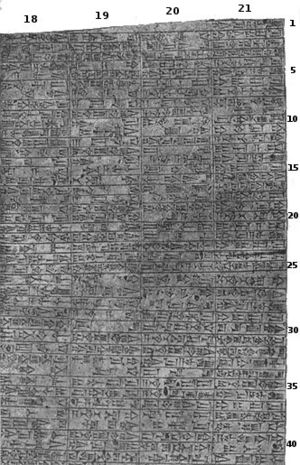18th century BC facts for kids
| Millennium: | 2nd millennium BC |
|---|---|
| Centuries: | 19th century BC · 18th century BC · 17th century BC |
| Decades: | 1790s BC 1780s BC 1770s BC 1760s BC 1750s BC 1740s BC 1730s BC 1720s BC 1710s BC 1700s BC |
| Categories: | Births – Deaths Establishments – Disestablishments |
The 18th century BCE was a time long, long ago, from 1800 BCE to 1701 BCE. BCE stands for "Before Common Era," which is like saying "Before Christ." This century saw many important events in ancient civilizations, like the rise of powerful kings and new ways of life across the world.
Contents
Important Events of the 18th Century BCE

An inscription of the Code of Hammurabi, one of the earliest known sets of laws
This century was a busy time for many ancient cultures. People started using new tools, powerful kingdoms grew, and some older civilizations began to change.
New Ages and Cultures Begin
- Around 1800 BCE: The Iron Age began in India. This was a time when people started making tools and weapons from iron, which was stronger than bronze.
- Around 1800 BCE: The Nordic Bronze Age started in parts of Northern Europe. People here learned to work with bronze, making better tools and beautiful objects.
- Around 1800 BCE: Early Mayan communities began to settle down in Mesoamerica, which is modern-day Mexico and Central America. They started building villages and farming.
- Around 1750 BCE: The Vedic period began in India. This was when nomadic shepherds, called the Aryans, arrived from Central Asia. They brought new ideas and traditions that shaped Indian culture.
The Rise of Babylon and Hammurabi
- Around 1792 BCE – 1750 BCE: A very famous king named Hammurabi ruled Babylonia. Babylonia was a powerful kingdom in Mesopotamia, which is modern-day Iraq.
- Hammurabi was known for creating one of the earliest and most complete sets of laws, called the Code of Hammurabi. This code was carved onto a large stone pillar, showing how people should live and what punishments they would face for breaking rules.
- 1770 BCE: The city of Babylon, Hammurabi's capital, became the largest city in the world. It took this title from Thebes, an important city in Ancient Egypt.
- 1764 BCE – 1750 BCE: Hammurabi fought many wars to expand his kingdom. He conquered other cities like Mari in 1757 BCE, destroying its royal palace.
Changes in Egypt and China
- Around 1800 BCE: A group of people called the Hyksos started to settle in the Nile Delta in Egypt. Their main city was Avaris.
- 1786 BCE: In Egypt, Queen Sobekneferu died. This marked the end of the powerful Twelfth Dynasty and the beginning of new dynasties.
- 1766 BCE: In China, the Shang Dynasty began its rule. They conquered the earlier Xia Dynasty, becoming a major power in ancient China. This also marked the start of the Bronze Age in China.
- Around 1750 BCE: The Hyksos gained more control and occupied Northern Egypt.
Other Important Events
- Around 1800 BCE – 1300 BCE: The ancient city of Troy VI flourished. This city, located in modern-day Turkey, was an important trading center.
- 1750 BCE: A very large volcano erupted at Mount Veniaminof in Alaska.
- Around 1700 BCE: The Indus Valley Civilization in what is now Pakistan and India began to decline and eventually ended. However, some of its traditions continued in new cultures.
- Around 1700 BCE: The Minoan civilization on the island of Crete saw the end of its Old Palace period and the start of its Second Palace period. This was a time of great building and art.
- Around 1700 BCE: The last species of mammoth became extinct on Wrangel Island, a remote island in the Arctic Ocean.
Important People
- Hammurabi (1792 BCE–1750 BCE): He was the famous king of the Babylonian Empire. He is best known for his strict code of laws, which helped organize society in his kingdom.
- Tang: He was the leader who overthrew the last emperor of the Xia dynasty, Emperor Jie. Tang then founded the Shang Dynasty, which became a powerful and important part of ancient Chinese history.
Discoveries and Mysteries
- Around 1700 BCE: The Phaistos Disc was made. This is a mysterious clay disc covered with strange symbols. No one knows for sure what it means, where it came from, or what its purpose was. It remains one of the biggest puzzles for archaeologists today!
See also
 In Spanish: Siglo XVIII a. C. para niños
In Spanish: Siglo XVIII a. C. para niños

All content from Kiddle encyclopedia articles (including the article images and facts) can be freely used under Attribution-ShareAlike license, unless stated otherwise. Cite this article:
18th century BC Facts for Kids. Kiddle Encyclopedia.
